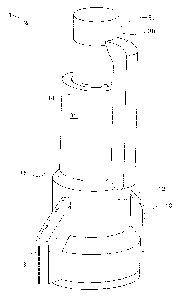Some of the information on this Web page has been provided by external sources. The Government of Canada is not responsible for the accuracy, reliability or currency of the information supplied by external sources. Users wishing to rely upon this information should consult directly with the source of the information. Content provided by external sources is not subject to official languages, privacy and accessibility requirements.
Any discrepancies in the text and image of the Claims and Abstract are due to differing posting times. Text of the Claims and Abstract are posted:
| (12) Patent: | (11) CA 3216910 |
|---|---|
| (54) English Title: | ELECTRICAL CONNECTOR WITH CURE-IN-PLACE RESIN |
| (54) French Title: | CONNECTEUR ELECTRIQUE AVEC RESINE A DURCISSEMENT EN PLACE |
| Status: | Granted and Issued |
| (51) International Patent Classification (IPC): |
|
|---|---|
| (72) Inventors : |
|
| (73) Owners : |
|
| (71) Applicants : |
|
| (74) Agent: | GOWLING WLG (CANADA) LLP |
| (74) Associate agent: | |
| (45) Issued: | 2024-01-16 |
| (86) PCT Filing Date: | 2022-05-13 |
| (87) Open to Public Inspection: | 2022-12-01 |
| Examination requested: | 2023-10-26 |
| Availability of licence: | N/A |
| Dedicated to the Public: | N/A |
| (25) Language of filing: | English |
| Patent Cooperation Treaty (PCT): | Yes |
|---|---|
| (86) PCT Filing Number: | PCT/US2022/072307 |
| (87) International Publication Number: | US2022072307 |
| (85) National Entry: | 2023-10-26 |
| (30) Application Priority Data: | ||||||
|---|---|---|---|---|---|---|
|
The electrical connector with cure-in-place resin is a twist-on wire connector with integrated resin injection, the resin curing around the enclosed conductors. The resulting connection is permanent, maintaining connectivity and excluding water. At the tip of the body, a sliding cartridge holds a single or multi-part resin within one or more sealed chambers. After the conductors are introduced into the body, and the connector tightened into place, the sliding cartridge is pressed into the body. The sliding causes the cartridge to compress against a piercing tip, causing resin to pass into the body of the connector, curing around the conductors.
Le connecteur électrique avec la résine à durcissement en place est un connecteur de fil torsadé avec injection de résine intégrée, la résine durcissant autour des conducteurs enfermés. La connexion résultante est permanente, maintenant la connectivité et excluant l'eau. Au niveau de la pointe du corps, une cartouche coulissante maintient une résine à une ou plusieurs parties dans une ou plusieurs chambres scellées. Une fois que les conducteurs sont introduits dans le corps, et que le connecteur est serré, la cartouche coulissante est pressée dans le corps. Le coulissement amène la cartouche à se comprimer contre une pointe de perçage, amenant la résine à passer dans le corps du connecteur, durcissant autour des conducteurs.
Note: Claims are shown in the official language in which they were submitted.
Note: Descriptions are shown in the official language in which they were submitted.

2024-08-01:As part of the Next Generation Patents (NGP) transition, the Canadian Patents Database (CPD) now contains a more detailed Event History, which replicates the Event Log of our new back-office solution.
Please note that "Inactive:" events refers to events no longer in use in our new back-office solution.
For a clearer understanding of the status of the application/patent presented on this page, the site Disclaimer , as well as the definitions for Patent , Event History , Maintenance Fee and Payment History should be consulted.
| Description | Date |
|---|---|
| Letter Sent | 2024-01-16 |
| Inactive: Grant downloaded | 2024-01-16 |
| Inactive: Grant downloaded | 2024-01-16 |
| Grant by Issuance | 2024-01-16 |
| Inactive: Cover page published | 2024-01-15 |
| Pre-grant | 2023-12-05 |
| Inactive: Final fee received | 2023-12-05 |
| Notice of Allowance is Issued | 2023-11-27 |
| Letter Sent | 2023-11-27 |
| Inactive: Cover page published | 2023-11-23 |
| Inactive: Approved for allowance (AFA) | 2023-11-17 |
| Inactive: Report - QC failed - Minor | 2023-11-17 |
| Inactive: IPC assigned | 2023-11-01 |
| Inactive: IPC assigned | 2023-11-01 |
| Inactive: First IPC assigned | 2023-11-01 |
| Advanced Examination Determined Compliant - PPH | 2023-10-27 |
| Advanced Examination Requested - PPH | 2023-10-27 |
| Amendment Received - Voluntary Amendment | 2023-10-27 |
| Letter Sent | 2023-10-26 |
| All Requirements for Examination Determined Compliant | 2023-10-26 |
| Inactive: IPC assigned | 2023-10-26 |
| Letter sent | 2023-10-26 |
| Priority Claim Requirements Determined Compliant | 2023-10-26 |
| Request for Priority Received | 2023-10-26 |
| Small Entity Declaration Determined Compliant | 2023-10-26 |
| National Entry Requirements Determined Compliant | 2023-10-26 |
| Application Received - PCT | 2023-10-26 |
| Request for Examination Requirements Determined Compliant | 2023-10-26 |
| Application Published (Open to Public Inspection) | 2022-12-01 |
There is no abandonment history.
| Fee Type | Anniversary Year | Due Date | Paid Date |
|---|---|---|---|
| Request for examination - small | 2023-10-26 | ||
| Basic national fee - small | 2023-10-26 | ||
| Final fee - small | 2023-12-05 | ||
| MF (patent, 4th anniv.) - small | 2026-05-13 | 2024-03-29 | |
| MF (patent, 2nd anniv.) - small | 2024-05-13 | 2024-03-29 | |
| MF (patent, 3rd anniv.) - small | 2025-05-13 | 2024-03-29 |
Note: Records showing the ownership history in alphabetical order.
| Current Owners on Record |
|---|
| TAYLOR HARDIN |
| Past Owners on Record |
|---|
| None |